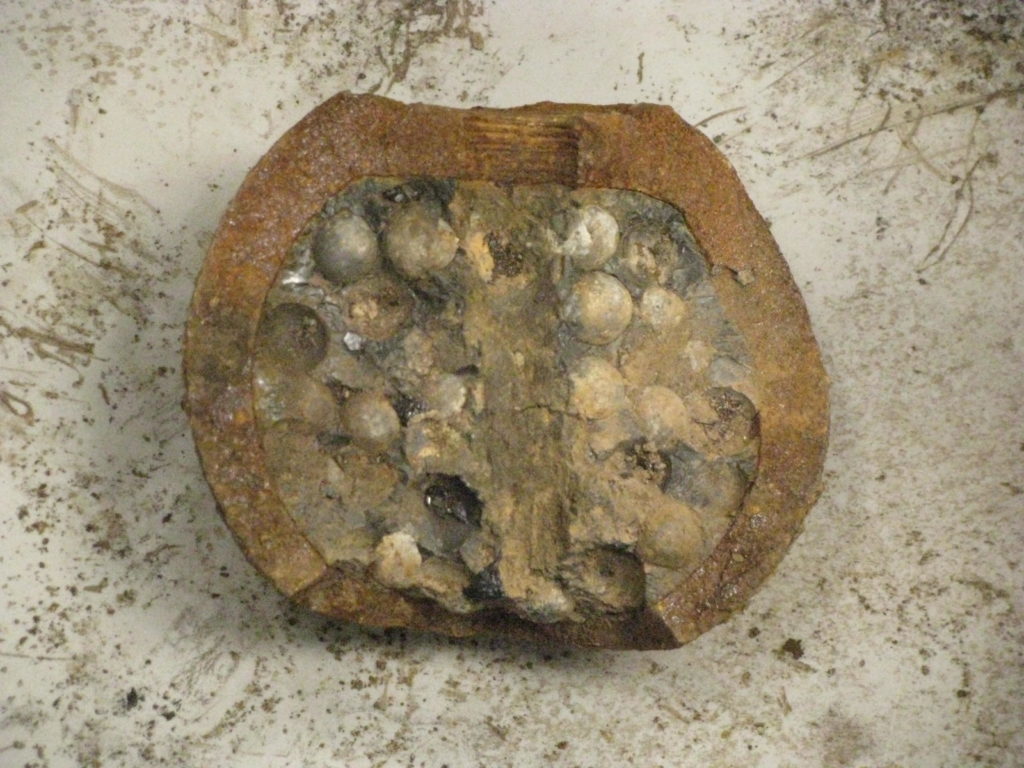I thought it would be clever to start the New Year off with “bang” by sharing this fun story about cannonballs. Yes, I said cannonballs.
One of the best things about my job here at the State Historic Preservation Office (SHPO) is that you never know what each new phone call or email is going to bring.
Of course, that can also be the worst thing about working here at the SHPO.
So, when I was contacted in my capacity as the Western Region Review Archaeologist about an unanticipated find during construction at a mixed commercial and residential development site in Lawrenceville, near Pittsburgh, I was cautiously intrigued.
When I learned that the find was more than 700 cannonballs from the Civil War-era Allegheny Arsenal site, I was amazed! When I discovered that the cannonballs were packed, fused, and ready to be fired, I was alarmed!!
Live military ordinance is NOT part of a typical day at the SHPO. At least at the Pennsylvania SHPO.
The Allegheny Arsenal was established in 1814 by the US Army. The Arsenal produced musket ammunition, cannonball, and various ordinance in large quantity during the War of 1812 and up through the end of the Civil War. The facility was decommissioned in 1905. Even though the Army no longer owns the land the Arsenal once occupied, any ordinance discovered remains US Government property.
The main entrance to the Allegheny Arsenal, taken between 1900 and 1915. Retrieved from the Library of Congress, https://www.loc.gov/item/det1994016702/PP/.
Thankfully, in situations such as this one, unexploded ordnance experts do most of the heavy lifting, at least initially. The cannonballs were removed from the site by experts over several weeks in late spring 2017 and eventually in mid-June returned to the United States Army.
And that, I thought, was that. Cannonballs were discovered. Cannonballs were returned to the US Army. Cannonballs would be safely decommissioned (i.e. blown up or exploded).
Essentially, all indicators, well, indicated that these artifacts, even though they had been found on an archaeological site in archaeological context, were to be more or less permanently removed from my small sphere of influence.
And then one steamy August afternoon my phone rang…
It was the Environmental Manager at Fort Indiantown Gap. Would the Pennsylvania Historical and Museum Commission like to come out to the Gap and collect a sample of some Civil War cannonballs that were recently decommissioned on the base? YES! Yes, we would!
A small portion of the decommissioned cannonballs found unexpectedly at the Allegheny Arsenal in Lawrenceville, PA.
And, as it sometimes can in the best of circumstances, everything came back around full circle. Within a couple of weeks from that phone call I found myself in a state van on the way out to Fort Indiantown Gap with Bob Hill, the State Museum’s Military Curator, as well as Janet Johnson and Jim Herbstritt from the State Museum’s Section of Archaeology.
Together we did some heavy lifting of our own and collected a sample of Allegheny Arsenal cannonball pieces for the State Museum as well as a sample to be passed on to the Heinz History Center in Pittsburgh. These artifacts will be conserved and permanently curated for research.
Curators retrieving now-safe cannonballs at Fort Indiantown Gap.
Hopefully someday soon the information gathered from the examination of these artifacts will further enlighten the history of the Allegheny Arsenal and its role in the US Civil War. I couldn’t be happier to have played a small part in retrieving this piece, however fragmented, of Pennsylvania history!
For more on the history of the Allegheny Arsenal and previous unanticipated discoveries at the site check out these related blog postings from the Heinz History Center and the PA National Guard.
Do you have any great stories about your own “unexpected finds” while studying an older building or archaeological site? Leave a comment to tell us about it!
Comment Policy
PHMC welcomes and encourages topic-related comments on this blog. PHMC reserves the right to remove comments that in PHMC’s discretion do not follow participation guidelines.
Commenters and Comments shall be related to the blog post topic and respectful of others who use this site.
Commenters and Comments shall not: use language that is offensive, inflammatory or provocative (this includes, but is not limited to, using profanity, obscene, or vulgar comments); disparage other commenters or people; condone illegal activity; identify the location of known or suspected archeological sites; post personal information in comments such as addresses, phone numbers, e-mail addresses or other contact details, which may relate to you or other individuals; impersonate or falsely claim to represent a person or an organization; make any commercial endorsement or promotion of any product, service or publication.
If you would like to comment on other topics not related to this blog post but related to PHMC, please fill out the PHMC Contact Us Form.
